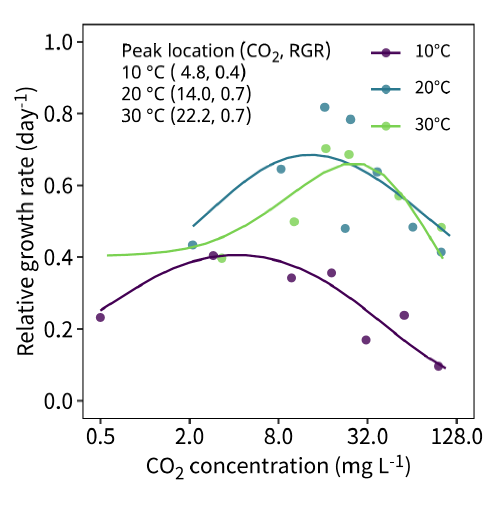Unlocking the Potential for Carbon Dioxide Removal (CDR) byUlva prolifera: How Does the Addition of CO2 Enhance Growth and Photosynthesis Rates?
Keywords:
Carbon dioxide, Carbon dioxide removal, Land-based aquaculture, Macroalga, Net photosynthetic rate, Relative growth rateAbstract
In Japan, climate change has led to decreasing yields of Ulva prolifera from aquaculture farms, and therefore land-based aquaculture techniques were developed for this species. We investigated how temperature and CO2 concentration affected relative growth rates (RGR) and net photosynthesis rates (NPR), with the intent to optimize the U. prolifera production in land-based aquaculture tanks. RGR and NPR of U. prolifera were measured at three temperature levels (10, 20, and 30°C) and a range of CO2 concentrations (0 to 200 mg L-1). To assess RGR, the samples were cultured for 6 days in flasks and the wet weight was recorded. To assess NPR, the increase in dissolved oxygen concentrations in 100 mL bottles was measured over time. A generalized additive model was fit to the data to elucidate the CO2 concentration that leads to maximum RGR and NPR.
RGR and NPR increased with increasing CO2 concentrations and declined after reaching a peak. Our analysis suggests that the maximum RGR occurred at CO2 concentrations of 4.8, 14.0, and 22.2 mg L-1 at 10, 20, and 30°C, respectively. Whereas the maximum NPR occurred at CO2 concentrations of 2.0, 13.8, and 3.5 mg L-1 at 10, 20, and 30°C, respectively. These results reveal that the addition of CO2 enhances growth and photosynthesis rates and provides us with valuable information regarding carbon dioxide removal (CDR) potential of U. prolifera aquaculture. Additional experiments are being done to verify these results, and to provide more insight regarding why a reduction in the CO2 concentration maximized NPR at 30°C.

